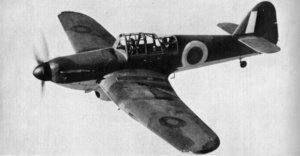Miles Master
|
|
The Miles Master was a 2-seat monoplane advanced trainer built by Miles Aircraft Ltd for the Royal Air Force and Fleet Air Arm during World War II. It went through a number of variants according to engine availability and was even modified as an emergency fighter during the Battle of Britain. It was a fast, strong and fully aerobatic aircraft and served as an excellent introduction to the high performance fighter aircraft of the day; the Spitfire and Hurricane.
The M.9A Master I was based on the M.9 Kestrel trainer that was first demonstrated at the Hendon Airshow in July 1937 but never entered production. The M.9 Kestrel, powered by the 745 hp (555 kW) Rolls-Royce Kestrel XVI engine, could reach 295 mph (475 km/h), however the production Master I, which first flew on 31 March, 1939, used the lower powered 715 hp (535 kW) Rolls-Royce Kestrel XXX Vee-type engine, reducing the maximum speed, yet it remained one of the fastest and most maneuverable trainers of its day. Entering service just before the start of the war, 900 Mk.I and Mk.IA Masters were built. This included 26 built as the M.24 Master Fighter which were modified to a single-seat configuration and armed with six .303 in machine guns.
When production of the Kestrel engine ceased, a new variant of the Master was designed to use the 870 hp (650 kW) air-cooled radial Bristol Mercury XX engine. The first M.19 Master II prototype flew on 30 October, 1939 and 1,699 were eventually built. When the Lend-Lease programme began to supply engines from the United States, a third variant of the Master, the M.27 Master III was designed, powered by the 825 hp (615 kW) Pratt & Whitney Twin Wasp Junior two-row radial engine. A total of 602 Master IIIs were built before production of the Master ceased in 1942 and production of the Miles Martinet took over. By the end of its production life, 3,227 Masters had been built, the most of any Miles aircraft.
The Master was equipped to carry eight practice bombs and one .303 Vickers machine gun mounted in the front fuselage. In 1942, all variants had their wings clipped by one metre to reduce stress on the wings and increase maneuverability.
| Contents |
Specifications (Mk I)
General characteristics
- Crew: 2, instructor & student
- Length: 30 ft 5 in (9.27 m)
- Wingspan: 35 ft 7 in (10.85 m) clipped
- Height: 9 ft 3 in (2.82 m)
- Wing area: 217 ft² (20.2 m²)
- Empty: 4,160 lb (1,886 kg)
- Loaded: 5,352 lb (2,428 kg)
- Maximum takeoff: lb ( kg)
- Powerplant: 1x Rolls-Royce Kestrel XXX Vee type, 715 hp (535 kW)
Performance
- Maximum speed: 226 mph at 15,000 ft (364 km/h at 5,000 m)
- Range: 500 miles (805 km)
- Service ceiling: 28,000 ft (8,500 m)
- Rate of climb: 1,500 ft/min (450 m/min)
- Wing loading: 24.7 lb/ft² (120 kg/m²)
- Power/mass: 0.14 hp/lb (0.23 kW/kg)
Armament
- provision for 1x .303 in Vickers machine gun
- 8x practice bombs on under-wing mounts
Related content
Related development: Miles Kestrel - Miles Martinet
Comparable aircraft: North American Harvard
Designation series: M.9 - M.9A - M.11 - M.12 - M.13 - M.14 - M.15 - M.16 - M.17 - M.18 - M.19 - M.20 - M.24 - M.25 - M.27
See also
|
Lists of Aircraft | Aircraft manufacturers | Aircraft engines | Aircraft engine manufacturers Airports | Airlines | Air forces | Aircraft weapons | Missiles | Timeline of aviation |

